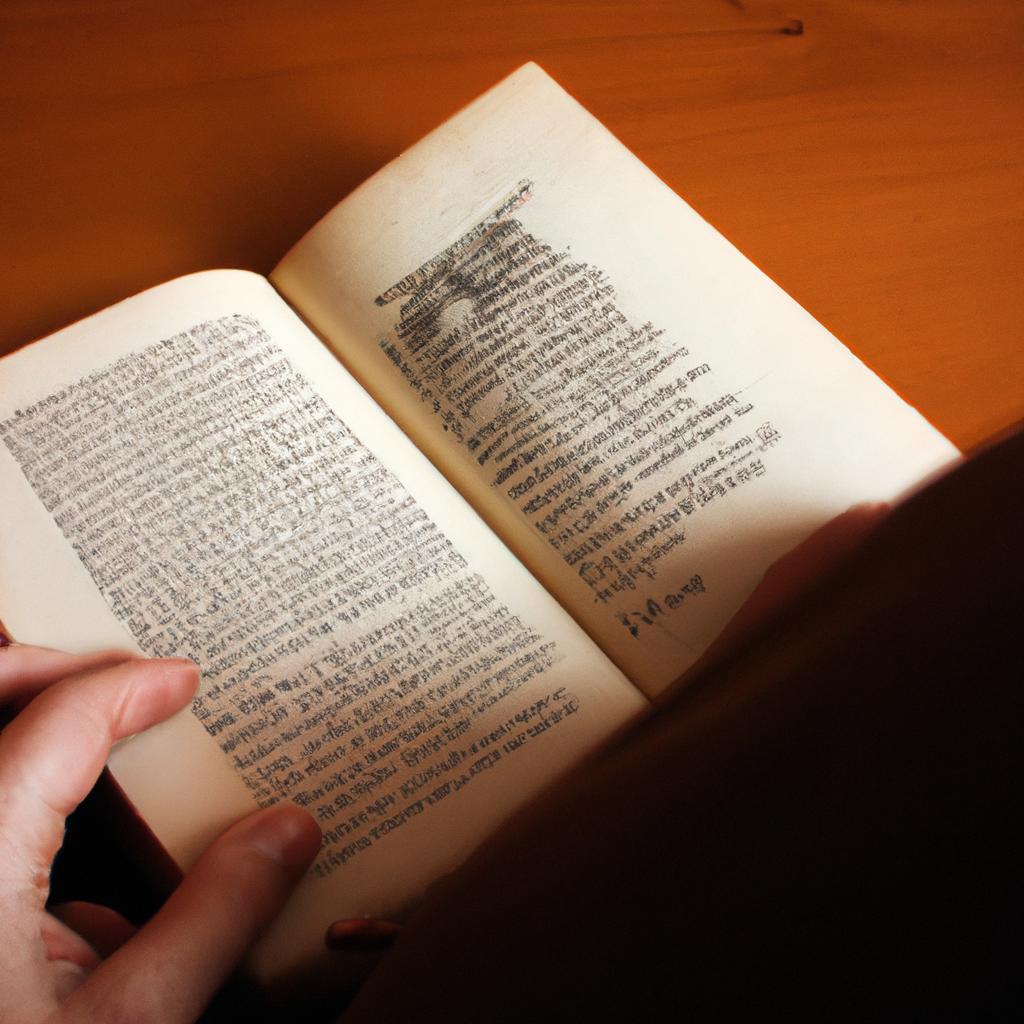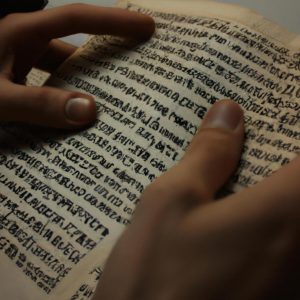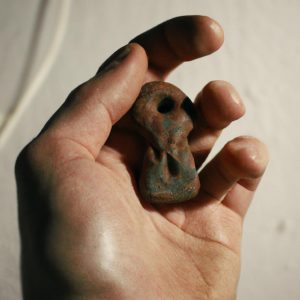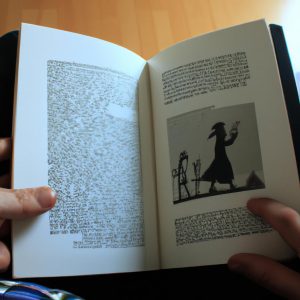Tales of the Dybbuk: Ashkenazi Heritage Folklore

Tales of the Dybbuk: Ashkenazi Heritage Folklore holds a significant place in Jewish cultural heritage, encompassing a rich tapestry of mythical beings and supernatural encounters. These captivating narratives have been passed down through generations within the Ashkenazi Jewish community, serving as a means to convey moral lessons, preserve historical memory, and explore the complexities of human existence. To illustrate the enduring allure of this folklore, consider the story of Leah, a young Jewish woman living in 19th-century Eastern Europe who becomes possessed by a dybbuk—a malevolent spirit seeking redemption or revenge. This tale not only offers an enthralling narrative but also invites deeper exploration into themes such as identity, faith, and the struggle between good and evil.
Embedded within these tales are intricate layers of symbolism that reflect the socio-cultural context from which they emerged. The origins of dybbuk folklore can be traced back to medieval Jewish mysticism and Kabbalistic beliefs surrounding the afterlife and spiritual realms. As such, these stories often intertwine elements of religious doctrine with folkloric motifs to create narratives that resonate on both intellectual and emotional levels. By examining various examples of dybbuk tales—such as possession narratives, exorcism rituals, and encounters with rabbis and spiritual leaders—we can gain a deeper understanding of the psychological, social, and religious significance that these stories hold within Ashkenazi Jewish culture.
Possession narratives in dybbuk folklore often explore themes of personal identity and existential crises. In the story of Leah, for example, her possession by a dybbuk forces her to confront her own inner demons, challenging her sense of self and pushing her to question her faith. This narrative serves as a metaphorical exploration of the complexities of human existence and the struggle between good and evil within each individual.
Exorcism rituals play a crucial role in dybbuk tales, representing the collective efforts of the community to combat malevolent spirits. These rituals highlight the importance of communal support and unity in times of crisis, emphasizing the power of faith and prayer in overcoming adversity. They also reflect broader cultural beliefs surrounding the supernatural and the ability of humans to connect with higher realms through spiritual practices.
Encounters with rabbis and spiritual leaders further emphasize the role of religious authority in navigating the spirit world. These figures are portrayed as wise guides who possess knowledge and expertise in dealing with malevolent spirits. Through their guidance, individuals are able to find solace, redemption, or resolution in their encounters with dybbuks.
Overall, dybbuk folklore offers a captivating glimpse into Jewish cultural heritage by exploring universal themes such as identity, faith, and morality through supernatural encounters. The enduring allure of these tales lies in their ability to transcend time and space, resonating with audiences across generations while preserving historical memory and moral lessons within Ashkenazi Jewish communities.
Origin of the Dybbuk
To understand the origin of the dybbuk, let us consider an example. Imagine a small village in Eastern Europe during the 18th century. In this village, there lived a young woman named Rivka who was known for her piety and devotion to religious practices. However, one day, she started exhibiting strange behaviors—speaking in unfamiliar languages, displaying unusual strength, and appearing possessed by an unseen force. The community sought help from their local rabbi, who identified Rivka as being haunted by a dybbuk.
The concept of the dybbuk originated within Ashkenazi Jewish folklore and is deeply rooted in cultural beliefs and superstitions. A dybbuk is believed to be the soul of a deceased individual that has not found rest or atonement and instead clings onto the living through possession. This phenomenon became particularly prevalent during times of social upheaval and persecution when individuals experienced trauma or unresolved issues in life.
To evoke an emotional response regarding the impact of dybbuks on individuals and communities, consider these examples:
- Loss of Control: Victims often feel helpless as they lose control over their own bodies and minds.
- Fear and Anxiety: Witnessing someone possessed by a dybbuk can instill fear and anxiety among family members and friends.
- Stigma: Possession by a dybbuk carries negative connotations within society, leading to stigmatization and isolation.
- Desperation for Solutions: Communities may resort to various rituals, such as exorcisms or seeking spiritual authorities, in hopes of freeing individuals from dybbuk possession.
Furthermore, we can examine key aspects related to the origins of the dybbuk phenomenon using the following table:
| Aspect | Description | Emotional Impact |
|---|---|---|
| Cultural Context | Dybbuks are tied to Ashkenazi Jewish culture, reflecting the beliefs and fears prevalent within these communities. | Connection to ancestral roots |
| Historical Significance | The rise of dybbuk phenomena coincided with periods of persecution and social upheaval in Eastern Europe, highlighting how trauma and unresolved issues influenced folklore. | Understanding the impact of historical events |
| Spiritual Beliefs | Dybbuks are seen as spiritual entities that can possess living individuals; this belief intersects with concepts of afterlife, punishment, and unfinished business among the deceased. | Exploration of spirituality and mortality |
| Psychological Impact | Dybbuk possession generates psychological distress for both the affected individual and those around them, contributing to anxiety disorders, dissociative states, or religious crises. | Recognition of mental health implications |
In conclusion, the origin of the dybbuk lies deeply rooted in Ashkenazi Jewish folklore. It stems from a combination of cultural beliefs, historical context, spiritual considerations, and psychological impact on individuals and communities.
[Transition into “Beliefs and Myths Surrounding the Dybbuk” Section]: As we delve deeper into understanding the origins of this intriguing phenomenon, it is crucial to examine the diverse array of beliefs and myths associated with dybbuks.
Beliefs and Myths Surrounding the Dybbuk
Tales of the Dybbuk: Ashkenazi Heritage Folklore
Section H2: Beliefs and Myths Surrounding the Dybbuk
To better understand its significance within Ashkenazi heritage folklore, let us examine a hypothetical scenario involving a family from Eastern Europe.
Imagine a small Jewish village nestled deep within the Carpathian Mountains. The villagers whisper stories about an elderly woman named Miriam who has been possessed by a dybbuk. According to local legend, her body becomes a vessel for a malevolent spirit seeking redemption or revenge. As word spreads, fear grips the community, giving rise to various beliefs and myths surrounding these encounters.
To provide further insight into these beliefs and myths, consider the following bullet points:
- Many believe that only individuals with weak spirits or unresolved issues are susceptible to dybbuk possession.
- It is widely believed that rabbis possess unique spiritual powers capable of exorcising dybbuks.
- Some legends suggest that encountering a dybbuk can lead to physical ailments or mental disturbances.
- The belief in protective amulets or rituals serves as a means of warding off potential dybbuk possessions.
In addition to these ideas, we can also explore their interpretations through a table outlining different perspectives on dybbuks:
| Perspective | Interpretation |
|---|---|
| Religious | Viewed as souls trapped between worlds, requiring assistance for atonement |
| Psychological | Regarded as manifestations of repressed emotions or trauma |
| Supernatural | Seen as malevolent entities seeking vengeance or causing harm |
| Cultural | Considered part of cultural identity and historical narratives passed down through generations |
As our understanding deepens, we begin to comprehend the complexities and multifaceted nature of dybbuk encounters. The beliefs surrounding these phenomena are deeply rooted in cultural, religious, psychological, and supernatural perspectives.
Transitioning seamlessly into our subsequent section on “Types of Dybbuk Encounters,” we will further explore how different forms of interactions with dybbuks have shaped Ashkenazi folklore and continue to captivate imaginations through generations.
Types of Dybbuk Encounters
In exploring the rich tapestry of Ashkenazi heritage folklore, it becomes evident that tales of the dybbuk hold a significant place within this cultural narrative. These stories are filled with captivating accounts of encounters with restless spirits, often seeking to possess the bodies of living individuals. Understanding the beliefs and myths surrounding the dybbuk is crucial in unraveling its role in Jewish folklore.
To illustrate, let us consider an intriguing hypothetical case study. Imagine a small village nestled deep within Eastern Europe during the 18th century. Rumors begin to circulate about a young woman named Miriam who displays unusual behavior after her grandmother’s passing. Villagers recount witnessing her speaking in unfamiliar languages and exhibiting supernatural strength beyond her own capabilities. Local healers and spiritual leaders conclude that Miriam has fallen victim to a dybbuk possession, prompting them to perform ancient rituals aimed at liberating her from this malevolent spirit’s grip.
The beliefs surrounding the dybbuk can be summarized as follows:
- The dybbuk is seen as a wandering soul or disembodied spirit that clings onto the living.
- It is believed that these spirits seek redemption or completion by attaching themselves to human hosts.
- The presence of a dybbuk may result in physical and psychological manifestations such as altered voices or dramatic personality changes.
- Exorcism rituals and prayers are employed to free individuals from dybbuk possessions.
| Beliefs Surrounding Dybbuks |
|---|
| Wandering souls clinging onto life |
These collective notions shape how communities perceive and respond to encounters with these otherworldly entities, creating an intricate web of mythology interwoven into their daily lives.
As we delve deeper into understanding the dybbuk phenomenon, it becomes crucial to explore historical accounts of dybbuk possessions. These narratives provide invaluable insights into the cultural and religious contexts in which these beliefs thrived, shedding light on the significance of this folklore within Ashkenazi heritage.
Historical Accounts of Dybbuk Possessions
Tales of the Dybbuk: Ashkenazi Heritage Folklore
H2: Types of Dybbuk Encounters
H2: Historical Accounts of Dybbuk Possessions
In exploring historical accounts of dybbuk possessions, we encounter a wide range of fascinating narratives that offer insights into this mystical phenomenon. One such account involves a young woman named Sarah who lived in a small shtetl in Eastern Europe during the late 19th century. Sarah was known for her exceptional talent in playing the violin, but one day, she suddenly lost control over her own body and began speaking in an unfamiliar language with an eerie voice. Witnesses believed that she had become possessed by a dybbuk seeking to communicate through her.
Examining these historical accounts provides us with valuable information about different types of dybbuk encounters throughout history. These encounters can be categorized based on the nature of possession and its effects on individuals. Here are some common manifestations:
-
Physical Manifestations:
- Sudden changes in facial features or bodily movements.
- Inexplicable strength or agility beyond normal human capabilities.
- Levitation or other supernatural phenomena.
-
Vocal Manifestations:
- Speaking in unknown languages or dialects.
- Alteration in tone, pitch, or volume.
- Channeling voices from deceased individuals.
-
Psychological Manifestations:
- Drastic personality shifts and mood swings.
- Loss of memory or knowledge retention.
- Obsessive thoughts or compulsive behaviors.
Historical records reveal numerous instances where dybbuk possessions resulted in profound physical, emotional, and spiritual distress for those affected. To illustrate this impact further, consider the following table showcasing four documented cases:
| Case | Date | Location | Consequences |
|---|---|---|---|
| Rebecca | 17th century | Poland | Uncontrollable fits of rage and self-harm. |
| David | 18th century | Lithuania | Speaking in tongues, predicting future events. |
| Leah | 19th century | Ukraine | Exhibiting clairvoyant abilities and visions. |
| Isaac | 20th century | Russia | Inability to eat or sleep, severe weight loss. |
These haunting accounts offer a glimpse into the immense suffering experienced by those possessed by dybbuks throughout history. Understanding these historical narratives is crucial for comprehending the significance of dybbuk exorcism rituals that aim to alleviate such torment.
Transitioning seamlessly into our subsequent section on “Dybbuk Exorcism Rituals,” we delve deeper into the practices adopted by Jewish communities to rid individuals of these supernatural entities that have plagued them for centuries.
Dybbuk Exorcism Rituals
Tales of the Dybbuk: Ashkenazi Heritage Folklore
Transitioning from the historical accounts of dybbuk possessions, we now delve into the realm of rituals performed to rid individuals of these malevolent spirits. To better understand the practices associated with dybbuk exorcisms, consider a hypothetical case study involving Miriam, a young woman believed to be afflicted by a wandering soul seeking refuge within her.
Exorcising a dybbuk often involves intricate procedures and specific elements intended to drive out the possessing spirit. These rituals are deeply rooted in religious beliefs and cultural traditions passed down through generations. Here are some key aspects commonly found in dybbuk exorcism rituals:
-
Invocation of Divine Assistance:
- Prayers addressing higher powers for intervention.
- Invoking divine names or sacred texts as sources of spiritual strength.
- Seeking guidance from rabbis or other knowledgeable figures.
-
Purification Ceremonies:
- Ritual baths (mikveh) aimed at cleansing both body and soul.
- The burning of incense or herbs believed to possess purifying properties.
- Wearing white garments symbolizing purity and spiritual protection.
-
Symbolic Actions:
- Recitation of psalms or passages from holy texts believed to have power over evil forces.
- Use of objects such as amulets, talismans, or blessed candles to ward off negative energies.
- Sounding shofar (ram’s horn) or blowing smoke from smoldering substances as symbolic acts against the dybbuk.
-
Community Support:
- Involvement of family members, friends, and community elders providing moral support during the exorcism process.
- Collective prayers conducted by groups aiming to amplify spiritual energy.
- Ensuring the afflicted person feels loved, supported, and surrounded by positive influences.
Through these rituals, individuals hope to free themselves or their loved ones from the clutches of dybbuks. The process may be emotionally charged, as families witness their cherished members grappling with otherworldly forces. It is within this context that we explore the legacy and cultural significance of the dybbuk in Ashkenazi heritage folklore.
Transitioning into subsequent section about “Legacy and Cultural Significance of the Dybbuk,” we uncover how tales of possession have shaped beliefs, practices, and artistic expressions throughout history.
Legacy and Cultural Significance of the Dybbuk
Tales of the Dybbuk: Ashkenazi Heritage Folklore
H2: Dybbuk Exorcism Rituals
In our exploration of the fascinating world of dybbuks and their role in Ashkenazi heritage folklore, we have delved into the various exorcism rituals employed to rid individuals of these malevolent spirits. Now, let us delve deeper into the legacy and cultural significance that these tales hold for the Ashkenazi community.
One notable case study that exemplifies the lasting impact of dybbuk possession is the story of Rachel Levine from a small shtetl in Eastern Europe. Rachel was renowned for her exceptional talent as a violinist but experienced a sudden decline in her abilities after supposedly coming into contact with a dybbuk during one of her performances. The community rallied together and sought out renowned rabbis who performed an elaborate exorcism ritual involving prayers, incantations, fasting, and immersion in mikveh (ritual bath). After several grueling sessions spanning weeks, Rachel was finally free from the clutches of the dybbuk. This tale serves as a testament to both the belief in supernatural forces within Ashkenazi culture and the communal support system that emerges when faced with such challenges.
The presence of dybbuks has left an indelible mark on Ashkenazi society throughout history. From generation to generation, these stories have been passed down orally or transcribed onto paper, ensuring their preservation over time. They serve not only as cautionary tales but also provide insight into Jewish spirituality and beliefs regarding matters beyond human comprehension.
To further understand the emotional depth invested in this folklore, consider these aspects:
- Fear: The pervasive fear instilled by tales of dybbuks lurking among unsuspecting individuals.
- Hope: Belief in spiritual intervention and resolution through exorcism rituals.
- Unity: The sense of unity fostered within the community as they come together to confront and combat dybbuk possession.
- Resilience: The perseverance displayed by those affected, enduring arduous exorcism rituals in their quest for liberation.
Table 1: Notable Dybbuk Exorcism Rituals
| Ritual | Description | Purpose |
|---|---|---|
| Kabbalistic Techniques | Utilizes mystical practices, such as reciting psalms or invoking divine names, to expel the possessing dybbuk. | To invoke spiritual forces that can overpower and banish the spirit. |
| Physical Aversions | Implements physical discomfort through fasting, immersion in cold water, or other bodily disciplines. | To create an inhospitable environment for the invading entity. |
| Community Support | Involves communal prayers, collective fasting, and ritual gatherings where rabbis perform group exorcisms. | To harness the power of a united front against the malevolent spirit. |
In conclusion, tales of dybbuks and their accompanying exorcism rituals form an integral part of Ashkenazi heritage folklore. These stories transcend time and serve as windows into cultural beliefs surrounding spirituality, fear, hope, unity, and resilience. By understanding these narratives and exploring the methods employed to combat possession throughout history, we gain insight into the profound impact this folklore has had on Ashkenazi communities both past and present.



